Pocket NAS: Synology DS409slim Review

“Green, Quiet and Reliable” – this is the slogan for the new Synology Disk Station DS409slim that is designed to provide users with a budget-friendly solution for easy file sharing and backup. It features snap-in 2.5″ hard drive design, comes with Synology Disk Station Manager 2.2 and offers excellent functionality.
Today’s SOHO-class Network Attached Storage devices are mostly designed for hard disk drives of the 3.5-inch form-factor. Such HDDs are rather inexpensive and have a large storage capacity (up to 2 terabytes), and some of them feature reduced power consumption and noise. A NAS does not present any special requirements to the speed of the hard disk. Considering the rather low speed of the platform and network interface, even the slowest of HDDs will not affect the speed of the client’s access to files.
However, the general trend towards miniaturization has reached NASes as well and 2.5-inch hard disk drives, usually found in notebooks, are now considered appropriate for NASes. Such HDDs consume less power and produce less heat than their larger counterparts but have somewhat lower speed characteristics. They are also more expensive and are inferior to 3.5-inchers in terms of maximum storage capacity, which is currently limited to only 500 gigabytes. Thus, it would take four or more disks to build a NAS comparable in capacity to a simple single-disk classic NAS. On the other hand, four disks make it possible to organize a fault-tolerant RAID5 array with a useful capacity of 75% from the total of its disks.
This solution is available from Synology, a leading developer of NAS products. The new DS409slim model can accommodate four 2.5-inch HDDs while measuring only 14 x 10.5 x 12 centimeters which is smaller than the size of typical NASes for two 3.5-inch disks. Let’s check out the other parameters of this solution right now.
Package and Accessories
The product box is designed in a simple way. It is made from cardboard and has plain black labels. A small photo and a list of technical specs are added with stickers. The box also shows the NAS’s serial number and MAC address.
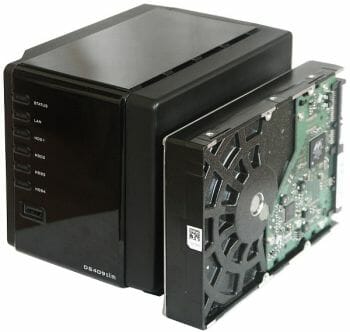
The box is 23.7 x 22.7 x 15.3 centimeters large and comparable to today’s 4-disk NASes for 3.5-inch drives. It has a plastic carry handle.
The NAS itself looks serious and top quality. As opposed to its size, its accessories have not been diminished. On the contrary, there is one new and original thing included. So, the box contains the NAS, some HDD screws, a network cable, a 12V/3A power adapter with power cord, stickers with numbers for HDD bays, a CD with software, and a quick installation guide. A localized version of the guide may also be included by the local distributor. The new accessory we’ve mentioned is a plastic stand that ensures sufficient air intake for the fan located at the bottom of the NAS. It also looks aesthetic enough if you don’t mind wiping dust off black glossy surfaces. You don’t have to use this stand if you put the NAS down on a clean and smooth surface of a desk, especially as this model has sturdy and tall rubber feet.
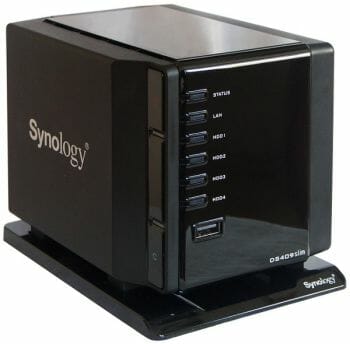
The software CD contains Synology’s traditional tools: DSAssistant for searching for NASes on the network and setting them up (Windows, MacOS, Linux), DownloadReplicator for managing file downloads (Windows, MacOS), and Data Replicator 3 for data backups (Windows only). The disc also contains user manuals in PDF format and firmware.
Exterior Design
The designers have done a good job on this NAS. The combination of lusterless and glossy black plastic looks beautiful and also illustrates the difference between these surfaces from a dactylographer’s point of view. The top, front and bottom panel are glossy. The sides and the back are matte.
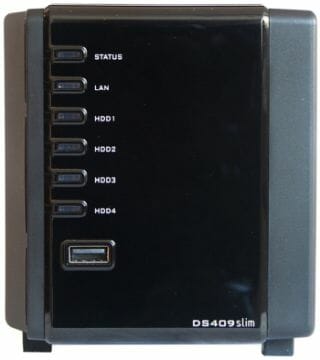
The nonstandard shape and the position of the indicators and buttons make the device even more interesting visually. The face panel has six LEDs reporting the status of the device in general, of the network connection and of each of the four installed HDDs. One USB port can also be seen here. To the left and almost on the edge of the case, there are well-hidden Power and Copy buttons as well as two more indicators (Power and USB drive connection).
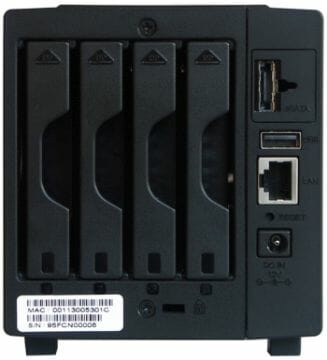
At the back we can see open HDD bays, eSATA and USB ports, a LAN connector, a power adapter connector, and a Reset button. It may be difficult to plug a network cable in if a thick flash drive is inserted into the USB port, but that’s a typical tradeoff for compactness. The appearance of the new NAS is gorgeous overall. It is both beautiful and practical.
Hardware Configuration
The DS409slim is not meant to be dismantled. HDDs are inserted from the outside. However, you can reach to its internals if you’ve got a strong desire and appropriate tools to do that. We don’t mind this difficulty, but it is not good that the user cannot easily access the fan for cleaning or replacement.
The NAS is built in a sturdy and simple way. It is based on a metallic frame PCBs and the plastic exterior are fastened to. Most of the electronic components are located on the main PCB. An additional PCB with HDD connectors is also employed.
On the hardware level, the NAS is based on a Marvell 88F6281 processor (codenamed Kirkwood, ARM core, 1.2GHz clock rate, without a heatsink). The system memory is one 128MB chip. A 4MB flash memory chip is used for the bootloader. The internal HDDs are connected to a Marvell 88SX7042 controller. A small card (14 x 9 centimeters) carries a few auxiliary chips like a USB hub, a LED indicators controller, etc. One of the unused connectors seems to be necessary for console access to restore firmware.
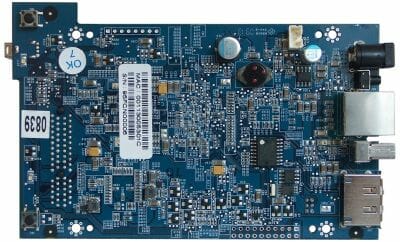
The NAS is cooled by a 60mm Evercool EC6010L12ER fan. It is located at the bottom of the device, so you should not install the latter on a soft surface. The fan is almost silent when working. Considering that 2.5-inch HDDs are generally quiet as well, this NAS will be optimal for home applications. The HDDs were never hotter than 40°C during our tests. The chips on the system PCB were up to 55°C hot.
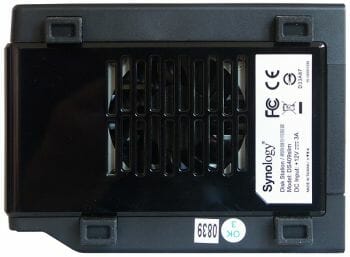
The unipolar power supply allows installing this device into your car, for example, but a more “industrial” case would be appropriate then. This also allows powering the system up autonomously for a long time, especially as its power consumption is rather low. According to the manufacturer, the NAS needs no more than 20W under load, so it will work very long if powered by an UPS.
Prep Work
The assembly is simple: you secure your HDDs on the frames and insert them into the NAS. We have some apprehensions about this fastening as each frame is only held by a SATA connector and a small plastic lock. On the other hand, most users won’t be reinstalling their HDDs too often.
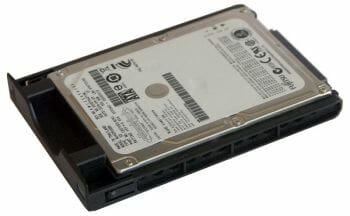
Then you connect the NAS to your network and launch the DSAssistant tool on a computer from the local network segment. DSAssistant works without installation and is actually needed only once for initializing the NAS. Afterwards, you can update the NAS’s firmware via its web interface.
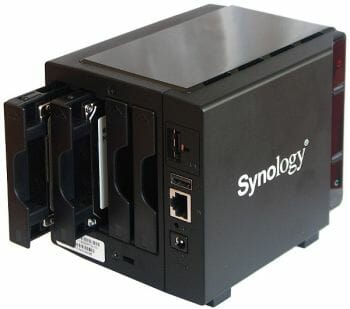
We used firmware version 0845 for our tests but the functionality will be described basing on the recently released version 0942.
The capabilities and settings are not specific to the DS409slim, of course. Synology provides almost the same firmware for all its models. There can only be some differences concerning specific parameters depending on performance (e.g. the maximum number of simultaneous downloads or IP video cameras). So, some configuration related issues have been omitted in this review. If you still have any questions, you can refer to our recent review of the DS509+. You will find more screenshots there, too.
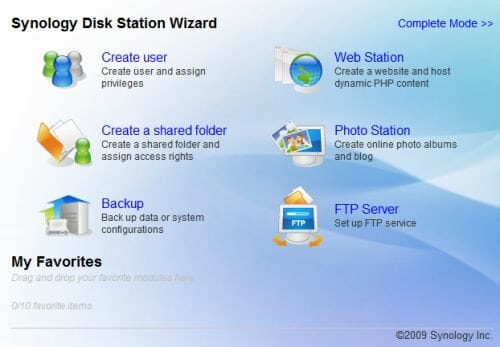
The NAS’s web-interface, pretty and handy, is based on Ajax. It is localized in a few languages and supports SSL with a self-signed certificate. By default, the interface works on port 5000 (5001 for https) but you can change it to any other port. For security reasons the user is automatically logged off the web-interface after being idle for a certain period of time.
Basic Functionality
The NAS can accommodate up to four 2.5-inch hard disk drives for storing user data and the integrated OS. You can view the model, serial number and firmware version of each HDD. Besides, you can view S.M.A.R.T. information (including temperature) and run a quick or full test described by that standard. Background processing of bad blocks is supported, but we used healthy HDDs and could not check out this issue.
Like most other NASes, the DS409slim allows building RAID arrays. It supports JBOD, RAID 0, 1, 5 and 6. If you install four disks, one of them can be a spare disk to be used automatically to restore the array when one of the main disks fails. There are only physical limitations as to the size and type of arrays. For example, you can have two disks in a mirror and two disks in a RAID0. The type and capacity of an array can be changed in some variants without losing data, which is useful for home users and allows upgrading the array without having to back up all the data to an external storage.
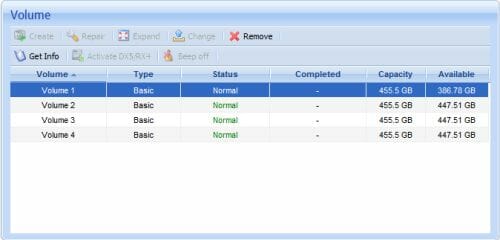
Besides RAID, the DS409slim supports iSCSI technology whose client is available in most of today’s OSes. Particularly, this technology can be used to create disk volumes for the OS itself and works via a program interface that emulates ordinary physical connections. For example, you can use any file system on an iSCSI volume or even work directly as with a block device. A total of 10 iSCSI volumes are supported simultaneously.
The disk space is allotted in the following way: 2.4GB for system purposes (about 400MB is occupied normally), 500MB for a swap file, and the rest is for data. The file system is ext3. You can read it from any Linux machine.
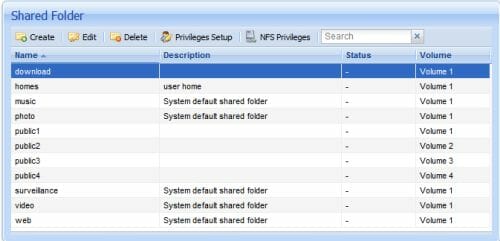
The DS409slim supports all modern network protocols for file access: SMB/CIFS, AFP, NFS and FTP. The NAS can be integrated into a domain on Windows networks. Besides, for this protocol you can enable a recycle bin for files deleted via network and choose a filename encoding for non-Unicode clients. MacOS X users can launch TimeMachine after specifying a shared folder on the NAS to be used by that backup utility. There are no settings for NFS. You can just turn this protocol on or off. FTP, on the contrary, abounds in settings like choosing ports (also for passive mode), turning encryption on/off, enabling Unicode support, and limiting the number of connections and speed. Thus, you can easily use FTP to securely access your files over the Internet.
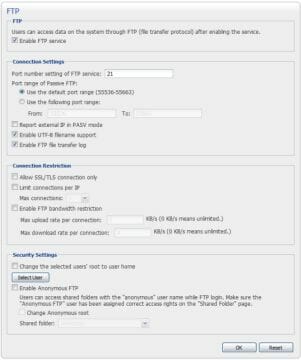
The user database can be either local or on a Windows domain. Besides name and password, you can enter a description, email and disk quotas for each user. You can enable the blocking of a user account after a specified date and prohibit the user to change his password. You can also allow or disallow each user to use specific services such as FTP, web-based file manager, audio station, download station, video surveillance. There is nothing special about user groups: you can edit them and enter their descriptions.
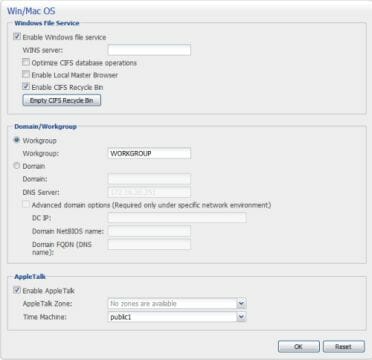
Access rights to public folders are specified in an ordinary way: no access, read only, read & write for groups and specific users. You can also enable the following FTP/HTTP access options for each folder: prohibit to view the files, prohibit to change the files, prohibit to download the files. There is a special list of rights for an autonomous FTP user.
For NFS you can create any number of entries with names of clients that are allowed access. You can specify the type of access (read only or reading & writing) and set the root squash parameter.
The NAS has one Gigabit Ethernet controller. It has a couple of indicators and supports Jumbo Frames up to 9000 bytes.
External Devices
The DS409slim has two USB ports (a connection via a USB hub is supported) and one eSATA connector for external devices such as storage devices, UPSes and printers. The NAS supports external storage with the FAT32, NTFS and EXT2/3 file systems. If there are multiple partitions on the hard disk, only the first of them will be accessible. The connected disk can be formatted from the NAS’s web-interface in FAT32 or EXT3.
Ordinary eSATA drives cannot be included into a RAID array. However, the DS409slim supports external DX5/RX4 enclosures for five and four disks, respectively (produced by Synology). HDDs installed in such enclosures can be fully integrated into the system.
The front USB port allows to copy data from the connected drive by pressing the dedicated button. The files are written into a subfolder named after the current data and time. The subfolder is created in a specified shared folder.
The UPS support is limited to shutting the NAS down in case of a power failure. You can choose the condition for that: waiting for the charge level to lower to a specific value, shutting down after a certain period of time, and shutting down immediately. An interesting feature available in the latest firmware is the emulation of a network UPS for five clients in which case you can use one UPS to power multiple NASes and shut them down all together when necessary.
System Settings
Now let’s check out the NAS’s network settings. These are its name, IP address and Jumbo Frames support. You can also make use of the integrated PPPoE and DDNS clients (with a few preset providers) as well as SNMP. If used on a large network, you can increase the NAS’s security by enabling the integrated firewall and the blocking of access when a password guessing attempt is detected.
The firewall is handy enough. Besides the standard parameters like address and port, you can use the names of the integrated services.
The integrated clock can be set up manually or synchronized via the Internet having first specified the time zone.
You can save/restore/reset the NAS’s settings and update its firmware. By the way, Synology often offers its users to beta-test new versions of firmware but you must be aware that you cannot easily downgrade the firmware.
The integrated logging feature is highly functional. Besides a standard list of events, you can view current connections and detailed information about what users connected via FTP or web manager have done. You can also read information about the backup copying services. Email and SMS (requires a subscription to a paid service) notifications are supported for remote reporting.
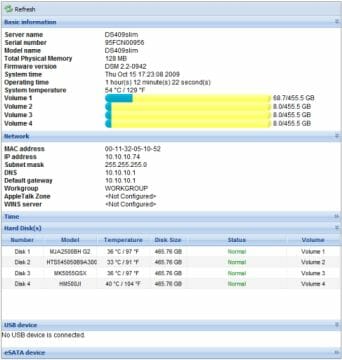
There are two pages in the web-interface that show that current status of the device. They provide summary information (name, addresses, firmware, disks, volumes, etc) and graphs (processor utilization, memory usage, network interface activity, total/free disk space).
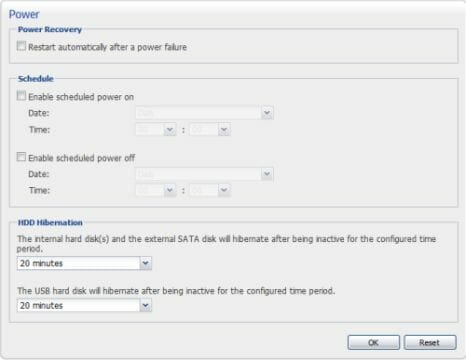
The power management options are limited to turning the internal and external (USB and eSATA) disks off when idle and turning the NAS on/off by a schedule.
Additional Features
One of the handiest extra features of Synology’s NASes is the convenient and functional file manager that works via a web browser. Of course, you can use FTP for remote access but this requires an appropriate client, settings NAT up on routers, etc. As opposed to that, a web-browser is available everywhere and the setting-up is limited to forwarding one port on the server’s side. After that the user gets full access to his data: you can download and upload files, delete/copy/transfer your data, change access rights and attributes of files and folders.
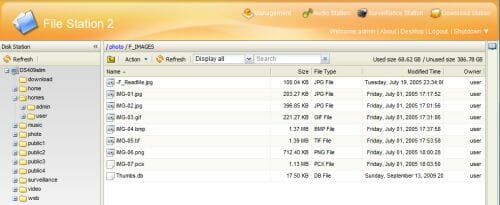
The service has a few settings: changing the picture in the top left corner of the interface and the overall color scheme, and settings alternative ports for file access. The last option may come in handy if you want to seed files but don’t want to show the interface of settings and other services.
What is interesting about this version of firmware is that the file manager is compatible with browsers in mobile devices: Internet Explore Mobile and Opera in Windows Mobile 6.0, Safari in iPhone OS and the integrated browser in Symbian OS 9.1, S60 3rd. Thus, you can download or view your files even from your smart-phone or communicator.
There are two more services based on Web technologies. The first of them is called Audio Station and it allows listening to musical recordings right from the browser page. The second service is Photo Station. It helps establish a site for hosting photographs and videos with comments and blogs.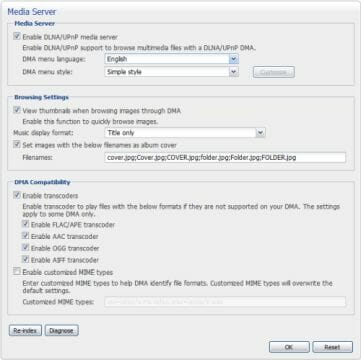
The NAS offers media servers: iTunes and UPnP AV/DLNA. And while we can’t say anything new about the former, the later has grown up considerably with this firmware version. Besides a unique selection of supported formats and clients, including WMP in Windows Vista, Sony PlayStation 3 and Microsoft Xbox 360, iPhone and iPod touch (with a free client from AppStore, music only), it can now transcode some audio formats which is going to be appreciated by the fans of the loss-less audio codecs flac and ape. Unfortunately, the media servers still work only with predefined folders with files and do not allow indexing some other folders.
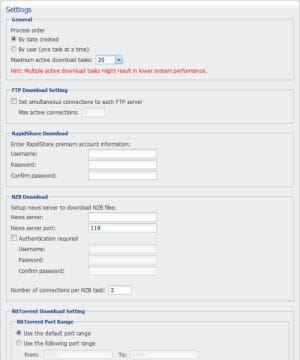
The autonomous file download station is flawless in Synology products. It is almost as functional as desktop download clients. It works fast and can seed downloaded files. The DS409slim may have up to 20 simultaneously active download tasks, which is usually quite enough to maintain high ratings. Besides BitTorrent, you can use the HTTP, FTP, NZB and Emule protocols. The new version of the download station can also download files from the RapidShare service.
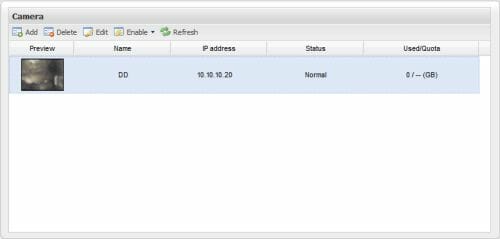
When it comes to video surveillance, the DS409slim can support up to eight IP cameras (a license for only one camera is included by default; you have to buy an additional license to use more cameras). The NAS is compatible with a few dozen models of web cameras, but any mjpeg or mpeg4 camera will usually do. The single serious limitation of the system is that you have to use Internet Explorer to utilize all features of mpeg4 cameras.
Web site developers may find the integrated hosting system (with php, MySQL and virtual website support) useful.
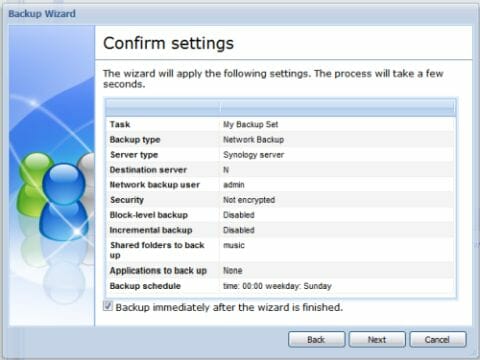
Backup copying of data is one of the most frequently used features of NAS devices. However, data on the NAS itself should be protected, too. You can use the integrated software module for that: it can make copies of data from shared folders to external media (USB or eSATA) or synchronize information between two NASes (both manufactured by Synology or compatible with rsync). Backup tasks can be launched manually or by a schedule.
Functionality Enhancements
Although the NAS’s default functionality is broad enough, you may still find that something is amiss and you lack some feature.
Synology offers two ways to solve that problem. You can install ready-made add-ins via the web interface or make use of the full access to the OS via a console.
There are four ready-made modules:
- SqueezeCenter: this server can provide musical files and radio to Logitech SqueezeBox devices.
- Mail Station: a modern mail server with support for SMTP, POP3, IMAP and Web access.
- Webalizer: a module to view statistics for the NAS’s web services.
- phpMyAdmin: database management software for the integrated MySQL server.
The console access is implemented via telnet and ssh protocols. Considering that there is over 2 gigabytes of free space on the system partition and that you can use the other disk volumes too, the possibilities are limitless. One of the simplest package installation methods is Optware described in the WiKi section of the Synology website.
Performance
We could not get together four identical HDDs for this test. Instead, we collected four 500GB models from different generations: Fujitsu MJA2500BH, Hitachi HTS545050B9A300, Toshiba MK5055GSX and Samsung HM500JI. The other test conditions are the same as in our previous NAS tests: a mainstream PC with a dual-core processor and a Gigabit Ethernet controller works as a client. It runs 32-bit Windows Vista and is connected to the NAS via Gigabit Ethernet switch. Jumbo Frames are turned on. Intel NASPT 1.7.0 is used as the benchmark.
As we’ve got four different HDDs today, let’s first see if the HDD model affects the performance of the NAS. We used single-disk volumes in this test.
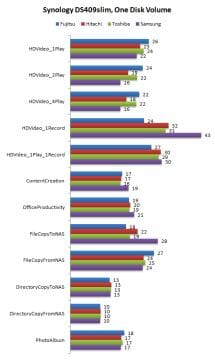
The results suggest that the HDDs differ considerably with streaming data patterns. There is no overall winner, though. The Fujitsu is good at reading whereas the Samsung is the best at writing. On non-streaming operations the difference is negligible. So, you can choose HDDs for your NAS without looking for the highest-performance model. Instead, you should consider such factors as availability, price, capacity and personal preferences concerning particular brands.
Next let’s check out the NAS’s performance in different RAID modes. We had no problems using different disks in RAID arrays, by the way. There was no incompatibility or anything although the results perhaps would have been somewhat higher with identical HDDs.
The second graph shows the speed of RAID0 with different number of disks. Here and in the third diagram the average speed of our four models is shown as the speed of a single disk.
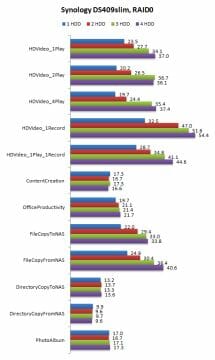
RAID0 helps improve the performance with streaming operations. The speed grows up to 37MBps at reading and 55MBps at writing. This is an impressive result for such a compact device and is largely due to the 1.2GHz processor. Comparing these numbers to the performance of other models based on the same processor, the DS409slim is much faster.
The third diagram shows the performance of the fault-tolerant RAID5 and RAID6 arrays. We guess RAID1 is not a good idea for this device in terms of overall cost. RAID6 isn’t quite appealing due to the same reason.
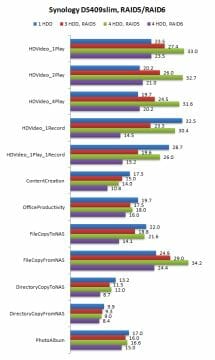
Calculating checksums is not an easy task for the ARM core. Fortunately, this is only necessary for writing data. The write speed of the RAID6 is only half that of the single disk. The 4-disk RAID5 is good, delivering a speed of 30MBps. Reading is much better. The RAID5 accelerates to 33MBps while the RAID6 is comparable to a single disk. Note also that the differences are less conspicuous with patterns consisting of a large number of small files.
Judging by the results, the 4-disk RAID5 is the best option if you need fault tolerance. This array can survive the loss of one disk and delivers good enough performance.
Conclusion
The DS409slim is going to be appreciated by users who prefer compact electronic devices. Although it can accommodate as many as four HDDs, its size is very small. Why? Because it uses 2.5-inch rather than 3.5-inch HDDs. This has not affected functionality. The DS409slim is a very capable NAS like any other model from Synology. We have not noticed any differences in terms of speed, either.
Thus, the single serious downside of the 2.5-inch NAS is that its storage capacity is smaller in comparison with 3.5-inch models. External drives with USB or eSATA interface can but partially mitigate the issue.
This pretty and interesting thing comes at a rather steep price of over $500 but you must be aware that it’s impossible to build a system of a comparable size out of standard components. So, if you need a very small but high-capacity and highly functional NAS for storing your valuable data, this model will make a good buy.